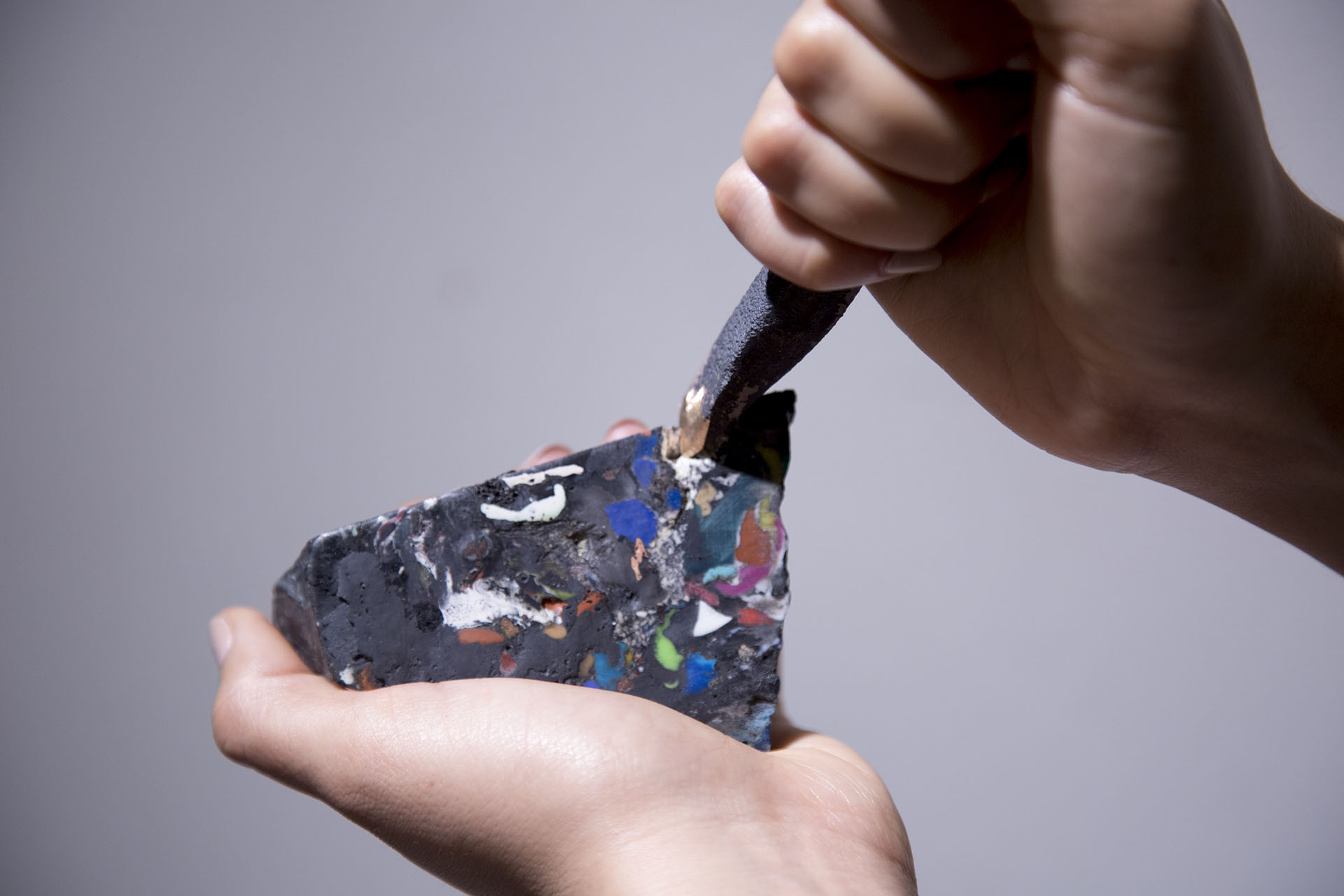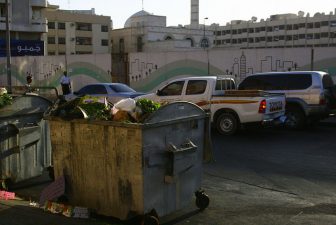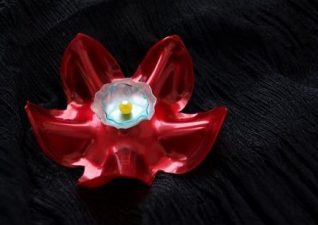Imagine the islands of garbage floating in the seas, the plastic bags filling the landfills. Shahar Livne, named Emerging Designer of the Year at the Deezeen Virtual Design Festival in May 2020, imagined all that plastic as a future material resource. Then she created the imagined new material. She calls it lithoplast. She follows in the footsteps of these 10 sustainable designers from Israel we featured all the way back in 2008.

Shahar Livne. by Charlotte Kin
Livne’s 2017 graduate project at the Design Academy Eindhoven was creating from plastic a sustainable material that can be adapted to multiple applications. This is not recycling, she emphasizes, but re-forming the texture and shape of plastic itself. Upcycling?

Lithoplast formed into a vessel
Livne used two industrial by-products, minestone and marble dust, in combination with plastic she garnered from beaches in Israel and Holland. Imitating the geological process called metamorphism, she applied pressure and heat to the layered materials. The result is a pliable material she calls Lithoplast.
“I call it Lithoplast from the Greek words for rock and moldable,” Livne said in an interview as part of the Dezeen Virtual Design Festival.
Livne quotes geologists she’s spoken to, who expect that if plastic continues to accumulate on the earth’s surface, it will hybridize with nature and start occurring naturally. In the future, she envisions, people will mine old plastic deposits as we mine for minerals today, in order to make materials from them.

Repurposing animal byproducts too
Now imagine, if you will, the garbage of slaughterhouses – blood, bones, fat. Livne takes this animal waste and re-creates it as a new kind of leather, as yarn, and as pigments for dyes. She calls it the Meat Factory Project.

Bioleather displayed on butcher’s hooks to emphasize its origin as blood.
Vegetarian herself, Livne takes a carefully neutral stance towards the relative good or evil of eating meat, hoping that her works raise questions in people’s minds which they will seek to answer themselves.
Her philosophy includes respecting animals in using every part of them. However, she confesses to a personal moral conflict in using slaughterhouse waste.
“Research was very hard, hauling buckets full of fresh blood still warm from the slaughter,” she says. “But as long as waste is here, it needs to be dealt with.”
She acknowledges that slaughter isn’t going to go away and adds, “This is something that happens anyway. Most of those materials get incinerated or reach waterways. For me, it’s a way to avoid further pollution. I don’t want to encourage them to kill more animals, but we have those resources, and I think they should be used. ”
Slaughterhouse waste leather
As part of the Meat Factory project, and in collaboration with sustainable luxury footwear brand Nat-2, Livne has designed sneakers with inserts resembling leather which is made of slaughterhouse waste. She calls it bioleather. The sneakers are made from rubber and cork, with the dark-red bioleather insert.
The formula for bioleather is secret, but Livne goes so far as to say she hopes to make the material waterproof in the future, and that Nat-2 will be able to make an entire shoe from it. She has also produced pigments in shades of orange and red from blood.

Sneakers bearing an insert of bioleather made from blood.
Bioleather can also be spun into yarn. Now imagine a sweater woven out of slaughterhouse waste. Does it creep you out? But such products are meant to raise consciousness.
“The Meat Factory project investigates the dissonance people have with the food on their plates and the living animal, and the psychological dissonance between raw materials and processed materials,” Livne says.
“It explores the emotional connection with nature that has changed since food and materials became industrialised, and consumers have been alienated from the source, content and use of animal-based materials,” she adds.
One of our long-time readers Pablo Solomon, an environmental artist, comments:
“While Shahar Livne is beautiful, creative and intelligent, I must just say that I have trouble when well meaning people want to go to these incredibly complicated methods to replace tried and true, environmentally friendly, sustainable products like—leather. Almost all meat scraps from slaughterhouses go into pet food.”
More sustainable design from Israel:
Junktion Upcycles Waste to Whimsey
Merav Feiglin’s recycled lights out of trash
Beauty Increases Sustainability, According to Designer Gadi Amit
Ten Sustainable Israeli Designers Who Reduce, Reuse & Recycle




